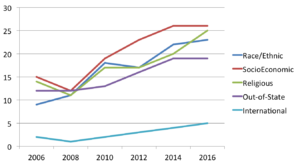I’ve always loved the Todd Rundgren song “The Want of a Nail.” In addition to a jumpin’ soul groove that could levitate a gospel choir, syncopated piano, punchy horn arrangements, and the legendary Bobby Womack singing call-and-response with Rundgren’s lead vocals (as if that weren’t enough!), the lyrics relay the old proverb “For Want of a Nail” that laments the loss of an entire kingdom due to the seemingly minor detail of a missing nail that would have kept a horse’s shoe attached to a lone steed during a fleeting cavalry charge.
After I wrote last week’s post comparing a couple of major pre-college predictors of first year success, I wondered again about whether there might be other key predictors of first year success that tend to fly just under the radar. I guess I’m thinking of the kinds of traits and attributes that, although they might not dominate a first impression, might just tip the balance for a student teetering on the edge of academic survival. In addition, by “under-the-radar” I’m referring to the type of variables that might normally get overshadowed in large-scale statistical analyses of college student success. These almost imperceptible influencers are often (for lack of a better term) predictors of predictors; like the way that a regular sleep schedule might increase the ability to focus when studying, which in turn increases one’s cognitive stamina during extended test-taking and ultimately improves the likelihood of a higher standardized test scores. Whether they are called “soft skills” in the popular press or “non-cognitive factors” in the academic press, it has become increasingly clear that these attributes matter for college success. So if we could figure out whether any of these attributes play a similar role among Augustana students who fell into that muddy middle of maybe when we were considering their application for admission, we might know a little bit more about teasing out just the right details in the process of trying to decide if a person is a good fit for Augustana or not.
Fortunately, we already collect some of this kind of data through the Student Readiness Survey that incoming freshmen take before attending summer registration. Although the Student Readiness Survey was primarily designed to better inform early conversations between advisors and new students, this data mirrors several of the soft skill traits and is ripe for testing as a predictor of first year success. To make sure we avoid the brute force effect (AKA when a typically powerful predictor like test score or high school GPA drowns out the more subtle impact of other potentially important factors), we took into account high school GPA throughout our analyses so that we could focus on the influence of these attributes and traits.
As a quick reminder, the Student Readiness Survey collects data on six non-cognitive factors or soft skills:
- Academic Habits (e.g., using a highlighter, planning ahead to do homework)
- Academic Confidence (e.g., belief in one’s ability to learn)
- Persistence and Grit (e.g., tendency to fight through difficulty to achieve a goal)
- Interpersonal Skills (e.g., tendency to consider multiple views in navigating conflict)
- Stress Management (e.g., perception of one’s temper or ability to be patient)
- Comfort with Social Interaction (e.g., ability to make new friends)
Sure enough, we found that two of these traits stood out as predictors of cumulative first-year GPA even after taking into account high school GPA. Can you guess which concepts rose to the top?
Although it might seem obvious, academic habits held up as a significant predictor of first year success. In other words, if you took two prospective students with similar high school GPAs, the one more likely to succeed would be the one who takes a more deliberate approach to academic habits, plans ahead, and studies actively rather than passively.
The second significant predictive trait turned out to be interpersonal skills. Specifically, we found that the more a student was inclined to consider another’s perspective as well as their own when negotiating a disagreement, the more likely they were to succeed as a first year student. Again, this finding took into account high school GPA. So if you were to consider two students with similar high school GPAs for admission, the one that seems to exhibit more sophisticated interpersonal skills may well be the one who is more likely to succeed. It’s important to note that this is not the same as leaning toward the student who seems more comfortable socially. In fact, our data suggests that there may be a small negative relationship between comfort with social interaction and first year success after taking into account high school GPA.
So what should we do with these findings? First of all, tread carefully. Applying these findings is sort of like fixing watches – one wrong move and you’ve turned a nifty time piece into an expensive paper weight. Moreover, these findings will only be useful when you put them in context with everything else you might know about a prospective student. Yet, when straining to find some whisper of evidence about a student’s potential for success, these may well be exactly the veins that you ought to mine. That doesn’t mean that you’ll necessarily find what you’re looking for, but it does mean that you know just a little bit more about where to look.
Although I’ve harped on this point in previous posts, I think it is worth repeating – a mountain of research demonstrates that the experiences during the first year are critical to student success, notwithstanding all sorts of pre-college characteristics. So nothing we might know about a prospective student before they start college rises to the level of slam-dunk proof of their future success or failure. But knowing just a little bit more about traits and attributes under the radar might help us make better decisions about students who seem to cluster at the margins.
Make it a good day,
Mark

